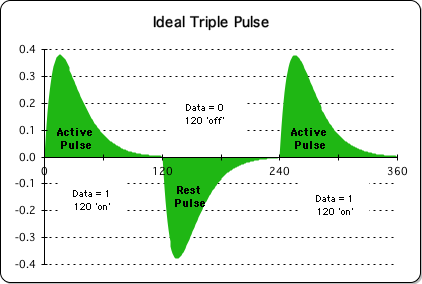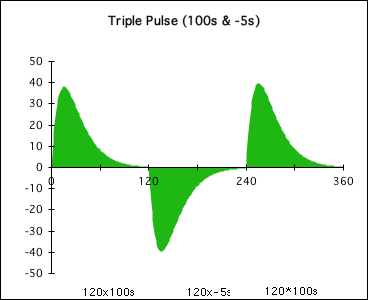- Introduction
- Cognitive Science's 10-minute Rule
- Triple Pulse & the 10-minute Rule: Patterns of Correspondence
- Triple Pulse & Shifting Modalities to refresh Attention
- Any Number Pair generates the Triple Pulse
- Evidence that shifting Cognitive Modalities refreshes Attention
Introduction
The 10-minute Rule, not Theory
The 10-minute Rule?
Psychological experiments have revealed that humans have a 10-minute attention span when learning new material. This result is so well established that it is called the 10-minute rule. Science typically evolves conservatively from hypothesis towards theory. Theory reflects the scientific community’s confidence in the confirmation of hypothesis. When the community chooses the word ‘rule’ to characterize theory, this confidence is particularly high.
What explanation does cognitive science provide?
What do scientists have to say about this phenomenon that has been experimentally verified so often? Why do humans have a hard time paying attention after 10 minutes? What is the mechanism behind the 10-minute rule? How are lecturers or teachers who speak for an hour or more able to adapt their presentations to the 10-minute attention barrier? What strategy is utilized and why does it work?
What does Living Algorithm mathematics reveal?
We have developed a mathematical system that is designed to model the capacity of living systems to digest information. The model is based upon the Living Algorithm’s method of digesting data streams. Before we can discuss the new insights that our Living Algorithm mathematics might provide on this matter, we need to know more about this well-studied behavioral curiosity.
Cognitive Science's 10-minute Rule
Experimental Results: 10-minutes of attention for new material.
What is the scientific community's stance on the 10-minute rule? We return to the esteemed Dr. Medina’s book brain rules, where he comments on this phenomenon:
"Peer-reviewed studies confirm…: Before the first quarter hour is over in a typical presentation, people have usually checked out. … What happens at the 10-minute mark to cause such trouble? Nobody knows. The brain seems to be making choices according to some stubborn timing pattern, undoubtedly influenced by both culture and gene." (Medina, brain rules, p. 74)
It is evident that humans in general have the ability to assimilate new information for about 10 minutes before 'checking out'. Scientists call this the 10-minute rule.
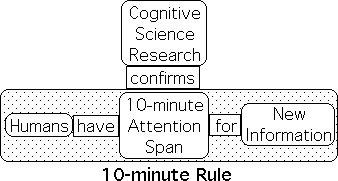
Although the 'why' behind the mechanism is a mystery, Medina suggests that it is a 'stubborn timing pattern' of the brain.
Solution: A Sequence of related, but unique, 10-minute Modules
What's the solution? Medina again:
"The 10-minute rule has been known for many years. … After 9 minutes and 59 seconds, the audience's attention is getting ready to plummet to near zero. … What do they need? Not more information of the same type. That would be like geese choking on food with no real chance to digest. … They need something so compelling that they blast through the 10-minute barrier and move on to new ground." (Medina, brain rules, pp. 90-91)
The esteemed Dr. Medina goes on to state his particular common sense solution to the problem. As a lecturer, he organizes his one-hour lectures into five 10-minute modules - each with a unique core concept. Dr. Medina received the Hoechst Marion Rousell Teacher of the Year Award. He attributes this award, at least in part, to this conscious modular design.
Triple Pulse & the 10-minute Rule: Patterns of Correspondence
Salient Features of 10-minute Rule
What are the salient features of the 10-minute rule? The listener has a pulse of attention that lasts for 10 minutes and then fades completely unless refreshed. The ability to comprehend and retain material falls precipitously after this point. Why? Medina suggests that it has to do with a 'stubborn timing pattern' in the brain.
10-minute Rule & the Pulse of Attention correspondence: 'Stubborn Timing Pattern' & Pulse
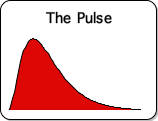
As mentioned, our mathematical model is based upon the Living Algorithm’s method of digesting data streams. When the Living Algorithm digests a data stream consisting solely of 1s, it generates a pulse that we call the Pulse of Attention. This Pulse of 1s also has a 'stubborn timing pattern'. No matter how many 1s are added to the string, it too fades completely after a set duration. Both the Pulse and the listener have a 'stubborn timing pattern' of distinct and limited duration when it comes to digesting a uniform data stream. It is evident that the mathematics of the Living Algorithm models the behavior of a listener who is governed by the 10-minute rule.

Correspondence: Consecutive 10-minute modules & Consecutive Pulses
To avoid the negative effects of this 'stubborn timing pattern' on the audience, Dr. Medina suggests that the lecturer should consider shifting core topics every ten minutes. If the focus of attention shifts from one topic to another every ten minutes, the brain experiences effective attention over a series of 10-minute pulses.
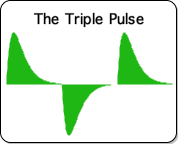
Similarly, when the Living Algorithm digests a data stream that regularly shifts from one uninterrupted number string to a different number string, this too generates a series of pulses, deemed the Triple Pulse. This shift from one number series of 120 data bits to a different series maximizes the dimensions of the Triple Pulse. Just as shifting from one number string to another maximizes the Triple Pulse dimensions, shifting from one topic to another maximizes our pulse-like ability to pay attention. It is evident that this alternation serves the same function – refreshing the potentials of both pulses. In this sense, Living Algorithm mathematics strongly correlates with Dr. Medina’s practical application of the 10-minute rule.
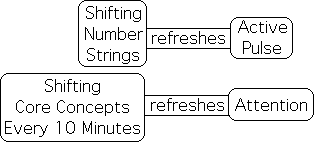
Triple Pulse & Shifting Modalities to refresh Attention
What kind of inferences can be drawn from the intriguing results regarding the 10-minute rule? In earlier articles, we've established patterns of correspondence between the Living Algorithm System and some significant features of behavioral reality. Let us briefly review these prior results to see what they reveal. Once the background is a bit clearer, we can ask: how well do the results of the current 10-minute rule investigation compare with the correspondences noted in the background discussion?
Triple Pulse mathematics mirrors the pulse-like nature of human behavior.
In prior observational studies, we have linked the Living Algorithm’s mathematics with a number of experimentally verified behavioral phenomena. The Triple Pulse studies focus upon the relationship between mathematical pulses. This mathematical relationship is analogous to a relationship, currently under scientific investigation, between significant pulse-like elements of human behavior. Our early comparisons focused upon the relationship between what can broadly be viewed as sleep and activity cycles. (For the specific studies see: Sleep Deprivation, Sleep Necessity, Importance of Naps and the Biology of Sleep.) Thus far, no contradictory results have been unearthed and the consistencies between the mathematical model and scientific investigation have been striking.
Our 10-minute rule discussion provides further validation of this correspondence.
Our discussion of the 10-minute rule appears to provide further validation of a relationship between empirical phenomena and Triple Pulse mathematics. The 10-minute rule conforms to a predictable pulse-like pattern that mirrors Triple Pulse behavior. Might we expand our definition of pulse-like behavior to include such notions as the mere shifting of attention? Will the mathematics of the Triple Pulse display a flexibility that explains other significant behaviors outside the sleep/wake cycle? Perhaps we are on a threshold of a new way of thinking about the applications of Triple Pulse mathematics.
To begin to even pose an answer to these questions, let’s revisit our mathematical model.
Could the Triple Pulse reflect a Modality Shift, as well as an On-Off cycle?
The ideal Triple Pulse consists of an alternation of an Active Pulse of 1s and a Rest Pulse of 0’s. (Graph shown at right. Please note there is a link below each graph that describes the unique nature of the Living Algorithm’s Graph Design.)
We found that Triple Pulse mathematics closely parallels the empirical results regarding the pulse-like nature of the sleep-wake cycle. This correspondence led us to associate the Active Pulse with waking consciousness and the Rest Pulse with unconscious sleep. In this sense, the binary data stream of 1s and 0s was likened to a system being on or off – as in the sleep/wake cycle. This on/off dynamic is one possible interpretation of the meaning of the numbers 1 and 0.
However, a 1 and a 0 can also be thought of as simply two different numbers. What are the implications of viewing the Triple Pulse Experiment from this new perspective?
Can Shifting Modalities have the same benefit as Sleep?
We’ve been looking at the Triple Pulse System in terms of an active period followed by a rest period. However, activity and rest need not be viewed as a binary choice between on and off. Is it possible to consider a change of activity as a substitute definition for the notion of rest? In a sense, if we broaden our definition, shifting mental gears may produce another manifestation of Triple Pulse behavior. For instance, after working on the computer for several hours one might feel the intense need for a break. It may not merely be the desire for coffee or lunch that is driving this sense of need. It could very well be that a shift to a different activity offers a different method of refreshing our cognitive abilities.
Could Shifting Mental Gears refresh our cognitive abilities?
We are suggesting that one doesn’t necessarily need to sleep in order to gain the benefit of the Rest Pulse. Sleeping and shifting mental gears might to be two unique methods of refreshing attention. Both are consistent with pulse-like behavior, and each enables us, in their own special way, to enter into the next active period refreshed. Perhaps the key to reaping the greatest benefit from our efforts lies in a broad notion of refreshment.

Any Number Pair generates the Triple Pulse
Does the mathematics of the Triple Pulse possess the flexibility to address this notion of refreshment via shifting modalities? If the data stream is comprised of number pairs other than 1s and 0s, what effect will this have on the Triple Pulse?
Triple Pulse Form remains the same despite different number pairs.
Our initial computer experiments regarding the Living Algorithm’s method of digesting data streams began by considering the simplest form. Although the Living Algorithm is capable of digesting an infinite variety of data streams, we began with the basic binary form. We employed a string of 1s and a string of 0s to produce the ideal Triple Pulse. However, we discovered that any number pair produces the same ideal Triple Pulse. The only requirement is that the data stream consists of an uninterrupted sequence of one number followed by an uninterrupted sequence of a different number. In other words, the data stream is not limited to the number pair 1 and 0, but can be generated by any number pair, for instance 1 and 2, 2 and 3, or 100 and -5. Whichever pair of numbers we choose, the ideal Triple Pulse is the result. Examine and compare the graph at the right with the ideal Triple Pulse (shown above).
Similarly, Elliptical Form remains the same despite different number pairs.
In similar fashion, no matter what number pair is fed into the equation for an ellipse, the equation still generates an ellipse. The number pair determines the dimensions of the ellipse, but the shape remains an ellipse. Just as the ellipse is the result of its own unique equation, the Triple Pulse is the result of the Living Algorithm’s unique digestive process. (Note: A single pair of numbers in the appropriate equation produces an ellipse. The Living Algorithm differs in that it takes a pair of number strings to produce the Triple Pulse.)
Each Number Pair could represent 2 Different Activities.
Let us suppose that each number pair symbolizes two different activities. For instance, the number ‘100’ might represent an exercise class and the number ‘-5’ might represent lunch with some friends. Please note that these numbers are being used in purely symbolic terms to represent 2 distinct classes of activities. In no way, should these numbers be interpreted as a type of quantifiable measure of any particular activity.
Triple Pulse mathematics could symbolize a shift in Modalities.
It seems safe to say that Triple Pulse mathematics could symbolically reflect a shift in modalities just as it reflects a shift between activity and rest. In addition to articulating the pulse-like relationship of activity and rest, the Triple Pulse may also articulate the pulse-like relationship of work to a coffee break, complementing class time with recess, or performance with intermission. A wise lecturer might choose to employ this understanding of a pulse-like relationship, in guiding the transition from topic-to-topic.
Evidence that shifting Cognitive Modalities refreshes Attention
An Essence of the Pulse-like Relationship is Refreshment.
The essence of the pulse-like relationship is refreshment. In the broadest sense, the key to refreshing the individual pulses of the Triple Pulse is the shift from the same content to alternate content. In other words, the initial pulse doesn’t need to be followed by a string of 0s during the middle pulse to refresh the potentials of the final pulse. The middle pulse can consist of any number string of sufficient duration and still refresh the subsequent Active Pulse.
Shifting Modalities to refresh Attention
When the middle pulse consists of a string of 0s, we call it the Rest Pulse because the 0s connote a break from activity. However, the alternate content of the middle number string can also symbolize, not rest, but an alternate activity. This alternate activity can take the form of a discrete shift from one class of activity to another. It could also consist of = a shift from one core concept to another within a single activity, as Dr. Medina suggests. We suggest that shifting modalities refreshes a human being’s ability to pay attention, just as alternating number strings refresh the dimensions of the Triple Pulse.
10-minute Rule as Evidence
There is certainly an abundance of evidence that supports the proposition that a 'stubborn timing pattern' causes the brain to lose its ability to pay attention after a set duration. Dr. Medina's personal experience with shifting core concepts to break through the 10-minute attention barrier is certainly a suggestive piece of evidence. Our culture provides myriad examples that suggest that we are aware of this need to refresh attention.
Institutionalized Customs as Evidence

There are a number of institutionalized customs that clearly presume that a shift from one activity to another provides cognitive refreshment. These practices include: breaks for lunch or coffee, chapters in a book, intermissions in a long performance, rounds in a boxing match, innings in baseball, or even 3-minute songs on pop radio. Each of these examples follows the peculiar pattern referenced by Dr. Medina. Informed by the mathematics of the Triple Pulse, we believe that shifting cognitive modalities successfully addresses this ‘stubborn timing pattern’. It does so by refreshing the brain's ability to pay attention, just as alternating the content of the number strings refreshes the Triple Pulse.
Triple Pulse Refreshment applies to activity to rest and activity to activity.
In summary, we suggest that 2 broad classes of behavioral relationships are characterized by the notion of Triple Pulse refreshment. This refreshment is provided both by a shift from activity to rest and by a shift from one particular activity to a different activity. Behavioral examples of the first relationship (activity to rest) include both nighttime slumber and the proverbial catnap. Pertinent examples of the second relationship (activity to activity) include both changing from one mode of behavior to another and changing core concepts at regular intervals within one particular activity. The mathematics behind the Triple Pulse model suggests that shifting cognitive modalities or topics is an effective way of refreshing an audience's attention or even one's own attention. This accords with both experimental evidence and institutionalized customs.

What does the Living Algorithm System say about a building lecture?
However, the above article does not address the building nature of a series of core concepts contained in a lecture. Our analysis has not yet dealt with the cumulative aspect of a performance or a concert. We intend to apply Living Algorithm mathematics to this significant aspect of human existence. To see what our model reveals, check out the next article in the series – Core Concept vs. Continuous Method of Lecturing.
Allegory Link
To return to the allegorical interaction between Life and the Living Algorithm, read The Living Algorithm must stretch to accommodate the 10-minute Rule.
